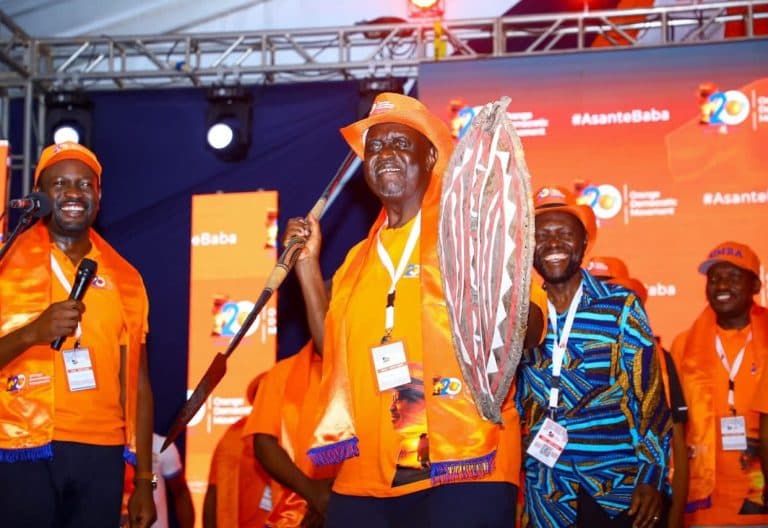Loading News Article...
We're loading the full news article for you. This includes the article content, images, author information, and related articles.
We're loading the full news article for you. This includes the article content, images, author information, and related articles.
Deep divisions over a pact with President Ruto’s government overshadow ODM's 20th anniversary, raising critical questions about the party's future identity and its historical role as Kenya's main opposition force.

MOMBASA, KENYA – The Orange Democratic Movement (ODM) marked its 20th anniversary with a three-day celebration in Mombasa that concluded on Sunday, November 16, 2025. While the event was intended to honour the legacy of its late founder, Raila Odinga, and chart a course for the future, it instead laid bare the deep ideological fissures threatening to tear the party apart. The core of the dispute centres on the party's continued participation in a "broad-based government" arrangement with President William Ruto's administration, a pact that has split the leadership into two distinct camps: those advocating for continued cooperation and those demanding a return to a robust opposition role.
The divisions were palpable during the anniversary events, which ran from Friday, November 14, to Sunday, November 16. The celebrations began just a day after the party's National Governing Council (NGC) met on Thursday, November 13, to formally approve a new leadership slate. Siaya Senator Dr. Oburu Oginga, brother of the late Raila Odinga, was confirmed as the new Party Leader. Homa Bay Governor Gladys Wanga was endorsed as National Chairperson, with Mombasa Governor Abdulswamad Nassir, Kisii Governor Simba Arati, and Vihiga Senator Godfrey Osotsi ratified as Deputy Party Leaders.
The fault lines within the party became starkly clear during the ODM Youth Convention on Friday, November 14. One faction, comprising senior leaders like Governor Wanga and Governor Nassir, has publicly supported the cooperation agreement with the government. They argue that this arrangement, initiated by Raila Odinga and President Ruto on March 7, 2025, ensures peace, stability, and development for their constituents. In a statement following a Central Committee Meeting on October 27, 2025, the party officially reiterated its commitment to the broad-based government until 2027.
However, a vocal and influential group of leaders vehemently opposes this trajectory, warning it will dilute ODM's identity and betray its history. Leading this charge is Siaya Governor James Orengo, a veteran of Kenyan opposition politics. During a fiery speech at the youth forum, Orengo dismissed the pro-government stance as a sign of cowardice. "We hear people talk of broad-based arrangements. ODM will not remain silent. Some have relaxed and are preaching accommodation," he stated on November 14. "I dare say, Ruto needs ODM; it's not ODM that needs Ruto... I don't know why this party is becoming a party of cowards."
His sentiments were echoed by ODM Secretary-General Edwin Sifuna and Deputy Party Leader Godfrey Osotsi. Sifuna lamented that some members were acting like "beggars" and pushed back against the notion that the party could not field its own presidential candidate in 2027. Senator Osotsi was unequivocal, declaring, "ODM is not a government party; we are an opposition party. So those who have been telling us different things, I want to tell them today, please give us a break."
The ideological struggle was not lost on the family of the party's founder. East African Legislative Assembly (EALA) MP Winnie Odinga, Raila Odinga's daughter, delivered a powerful rebuke to those fostering division. In a widely reported speech on November 14, she dismissed the talk of a split as "kelele ya chura"—the noise of a frog that cannot stop a cow from drinking water. She warned against clandestine dealings, stating, "I have heard there are those walking with us during the day and then trying to sell our party at night. ODM was not born in a bedroom, so its future will not be discussed as pillow talk." Her speech underscored the party's origins in protest and resistance, a legacy the pro-opposition faction claims is now under threat.
The new party leader, Dr. Oburu Oginga, has attempted to strike a conciliatory tone. While confirming his commitment to the broad-based government, he also sought to reassure party faithful that ODM would maintain its independence. "We shall not agree to be swallowed," Dr. Oginga stated during the NGC meeting on November 13. "Politically, you are as good as your numbers. People ask you what are you bringing on the table; if you are bringing nothing, they will just dismiss you."
The internal conflict within ODM, Kenya's largest and most resilient opposition party for two decades, has significant implications for the nation's political future. A weakened or fractured ODM could alter the 2027 electoral calculations, potentially leaving President Ruto with a less formidable opposition. Political analysts note that the party's ability to navigate this post-Raila transition will determine its survival and relevance. The party has a history of schisms, most notably the 2007 split that saw key figures like William Ruto and Kalonzo Musyoka part ways with Raila Odinga. The current divisions, occurring at a moment of foundational change, present a profound test of whether ODM can evolve from a movement centered on a charismatic leader into a durable, institution-driven political party.